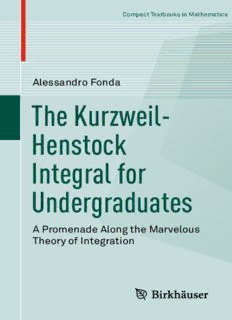
The Kurzweil-Henstock Integral for Undergraduates: A Promenade Along the Marvelous Theory of Integration PDF
Preview The Kurzweil-Henstock Integral for Undergraduates: A Promenade Along the Marvelous Theory of Integration
Compact Textbooks in Mathematics Alessandro Fonda The Kurzweil- Henstock Integral for Undergraduates A Promenade Along the Marvelous Theory of Integration CompactTextbooksinMathematics CompactTextbooksinMathematics This textbook series presents concise introductions to current topics in mathematicsandmainlyaddressesadvancedundergraduatesandmaster students. The concept is to offer small books covering subject matter equivalent to 2- or 3-hour lectures or seminars which are also suitable for self-study. The books provide students and teachers with new per- spectivesandnovelapproaches.Theyfeatureexamplesandexercisesto illustratekeyconceptsandapplicationsofthetheoreticalcontents.These- riesalsoincludestextbooksspecificallyspeakingtotheneedsofstudents fromotherdisciplinessuchasphysics,computerscience,engineering,life sciences,finance. • compact:smallbookspresentingtherelevantknowledge • learningmadeeasy:examplesandexercisesillustratetheapplication ofthecontents • usefulforlecturers:eachtitlecanserveasbasisandguidelinefora semestercourse/lecture/seminarof2–3hoursperweek. Moreinformationaboutthisseriesat:http://www.springer.com/series/11225 AlessandroFonda The Kurzweil-Henstock Integral for Undergraduates A Promenade Along the Marvelous Theory of Integration AlessandroFonda DipartimentodiMatematicaeGeoscienze Universita`degliStudidiTrieste Trieste,Italy ISSN2296-4568 ISSN2296-455X (electronic) CompactTextbooksinMathematics ISBN978-3-319-95320-5 ISBN978-3-319-95321-2 (eBook) https://doi.org/10.1007/978-3-319-95321-2 LibraryofCongressControlNumber:2018949935 MathematicsSubjectClassification(2010):26A39,26A42,26A63,26A66,26B15,26B20,28A75 ©SpringerNatureSwitzerlandAG2018 Thisworkissubjecttocopyright.AllrightsarereservedbythePublisher,whetherthewhole orpartofthematerialisconcerned,specificallytherightsoftranslation,reprinting,reuse ofillustrations,recitation,broadcasting,reproductiononmicrofilmsorinanyotherphysical way,andtransmissionorinformationstorageandretrieval,electronicadaptation,computer software,orbysimilarordissimilarmethodologynowknownorhereafterdeveloped. Theuseofgeneraldescriptivenames,registerednames,trademarks,servicemarks,etc.inthis publicationdoesnotimply,evenintheabsenceofaspecificstatement,thatsuchnamesare exemptfromtherelevantprotectivelawsandregulationsandthereforefreeforgeneraluse. Thepublisher,theauthors,andtheeditorsaresafetoassumethattheadviceandinformation inthisbookarebelievedtobetrueandaccurateatthedateofpublication.Neitherthe publishernortheauthorsortheeditorsgiveawarranty,expressorimplied,withrespect tothematerialcontainedhereinorforanyerrorsoromissionsthatmayhavebeenmade. Thepublisherremainsneutralwithregard tojurisdictionalclaimsinpublishedmapsand institutionalaffiliations. ThisbookispublishedundertheimprintBirkhäuser, www.birkhauser-science.combythe registeredcompanySpringerNatureSwitzerlandAG Theregisteredcompanyaddressis:Gewerbestrasse11,6330Cham,Switzerland v TheauthorwithJaroslavKurzweilinSeptember2008 To Sofia,Marcello,andElisa ix Introduction This book is the outcome of the beginners’ courses held over the past few years for my undergraduate students. The aim was to provide them with a general and sufficiently easy to grasp theory of the integral. The integral in question is indeed more general than Lebesgue’s in RN, but its construction is rather simple, since it makes use of Riemann sums which, beinggeometricallyviewable,areeasilyunderstandable. Thisapproachtothetheoryoftheintegralwasdevelopedindependently byJaroslavKurzweilandRalphHenstocksince1957(cf.[5,8]).Anumber ofbooksarenowavailable[1,4,6,7,9–13,15–19,21].However,Ifeelthat mostofthesemonographsareaddressedto anexpertreader, ratherthanto a beginner student. This is why I wanted to maintain here the exposition at a very didactical level, trying to avoid as much as possible unnecessary technicalities. Thebookisdividedintothreemainchaptersandfiveappendices,which Inowbrieflydescribe,mainlyasaguideforthelecturer. Thefirstchapteroutlinesthetheoryforfunctionsofonerealvariable.I have done my best to keep the explanation as simple as can be, following asfaraspossiblethelinesofthetheoryoftheRiemannintegral.However, therearesomeinterestingpeculiarities. ▬ The FundamentalTheorem of differential and integral calculus is very general and natural: one only has to assume the given function to be primitivable, i.e., to be the derivative of a differentiable function. The proofissimpleandclearlyshowsthelinkbetweendifferentiabilityand integrability. ▬ The generalized integral, on a bounded but not compact interval, is indeedastandardintegral:infact,Hake’stheoremshowsthatafunction having a generalized integral on such an interval can be extended to a function which is integrable in the standard sense on the closure of its domain. ▬ IntegrablefunctionsaccordingtoLebesguearethosefunctionswhichare integrableandwhoseabsolutevalueisintegrable,too. Inthesecondchapter,thetheoryisextendedtorealfunctionsofseveral real variables. No difficulties are encountered while considering functions defined on rectangles. When the functions are defined on more general domains, however, an obstacle arises concerning the property of additivity on subdomains. It is then necessary to limit one’s attention to functions which are integrable according to Lebesgue, after having introduced the concept of measurable set. On the other hand, for the Fubini Reduction TheoremthereisnoneedtodealwithLebesgueintegrablefunctions.Ithasa rathertechnicalbutconceptuallysimpleproof,whichonlymakesuseofthe x Introduction Kurzweil–Henstockdefinition.In theTheorem on theChangeofVariables intheintegral,onceagaincomplicationsmayarise(see,e.g.,[2]),sothatI againdecidedtolimitthediscussiononlytofunctionswhichareintegrable according to Lebesgue. The same goes for functions which are defined on unbounded sets. These difficulties are intrinsic, not only at an expository level,andresearchonsomeoftheseissuesisstillbeingcarriedout. Thethirdchapterillustratesthetheoryofdifferentialforms.Theaimis toprovetheclassicaltheoremscarryingthenameofStokes,andPoincaré’s theorem on exact differential forms. Dimension 3 has been considered closely:indeed,thetheoremsbyStokes–CartanandPoincaréareprovedin this chapter onlyin this case, and thereader is referred to AppendixB for the general proof. Also, I opted to discuss only thetheory for M-surfaces, withoutgeneralizingandextendingittomorecomplexgeometricalobjects (see however Appendix C). In some parts of this chapter, the regularity assumptions could be weakened, but I did not want to enter into a topic touchingastillongoingresearch. In Appendix A, the basic facts about differential calculus in RN are reviewed. InAppendixB,thetheoremsbyStokes–CartanandPoincaréareproved. Theproofsarerathertechnicalbutdonotpresentgreatconceptualdifficul- ties. In Appendix C, one can find a brief introduction to the theory of differentiable manifolds, with particular emphasis on the corresponding version of the Stokes–Cartan theorem. I did not want to deal with this argumentextensively,andtheproofsareonlysketched.Foramorecomplete treatment,wereferto[20]. InAppendixD,oneofthemostsurprisingresultsofmodernmathematics is reported, the so-called Banach–Tarski paradox. It states that a three- dimensional ball can be divided into a certain number of subsets which, aftersomewell-chosenrotationsandtranslations,finallygivetwoidentical copiesofthestartingball.Whyreportingonthisinabookaboutintegration? Well, the Banach–Tarski paradox shows the existence of sets which are notmeasurable(a rotation and a translation maintain the measureof a set, providedthissetismeasurable!),anditdoesthisinaveryspectacularway. AppendixEentailsashorthistoricalnoteontheevolutionoftheconcept ofintegral.Thisnoteisbynomeanscomplete.Theaimistogiveanideaof theroleplayedbytheRiemannsumsinthedifferentstagesofthehistoryof theintegral. Note ApreliminaryversionofthisbookwaspublishedinItalianunderthe title Lezioni sulla teoria dell’integrale. It has been revised here, extending andimprovingmostofthearguments. xi Contents 1 FunctionsofOneRealVariable................................. 1 AlessandroFonda 1.1 P-PartitionsandRiemannSums .................................... 1 1.2 TheNotionofδ-Fineness ........................................... 3 1.3 IntegrableFunctionsonaCompactInterval........................ 6 1.4 ElementaryPropertiesoftheIntegral .............................. 8 1.5 TheFundamentalTheorem......................................... 11 1.6 PrimitivableFunctions.............................................. 13 1.7 PrimitivationbyPartsandbySubstitution.......................... 18 1.8 TheCauchyCriterion ............................................... 23 1.9 IntegrabilityonSub-Intervals ...................................... 25 1.10 R-IntegrableFunctionsandContinuousFunctions.................. 28 1.11 TheSaks–HenstockTheorem....................................... 32 1.12 L-IntegrableFunctions ............................................. 35 1.13 TheMonotoneConvergenceTheorem.............................. 40 1.14 TheDominatedConvergenceTheorem............................. 45 1.15 IntegrationonNon-CompactIntervals ............................. 47 1.16 TheHakeTheorem ................................................. 53 1.17 IntegralsandSeries................................................. 56 2 FunctionsofSeveralRealVariables ............................ 61 AlessandroFonda 2.1 IntegrabilityonRectangles......................................... 61 2.2 IntegrabilityonaBoundedSet..................................... 66 2.3 TheMeasureofaBoundedSet ..................................... 68 2.4 TheChebyshevInequality.......................................... 72 2.5 NegligibleSets ..................................................... 73 2.6 ACharacterizationofBoundedMeasurableSets ................... 75 2.7 ContinuousFunctionsandL-IntegrableFunctions.................. 79 2.8 LimitsandDerivativesUndertheIntegrationSign.................. 82 2.9 TheReductionFormula............................................. 87 2.10 ChangeofVariablesintheIntegral................................. 96 2.11 ChangeofMeasurebyDiffeomorphisms ........................... 102 2.12 TheGeneralTheoremontheChangeofVariables.................. 104 2.13 SomeUsefulTransformationsinR2................................. 107 2.14 CylindricalandSphericalCoordinatesinR3 ........................ 110 2.15 TheIntegralonUnboundedSets ................................... 113 3 DifferentialForms ............................................... 125 AlessandroFonda 3.1 TheVectorSpaces(cid:3)M(RN)......................................... 125 3.2 DifferentialFormsinRN............................................ 127
Description: